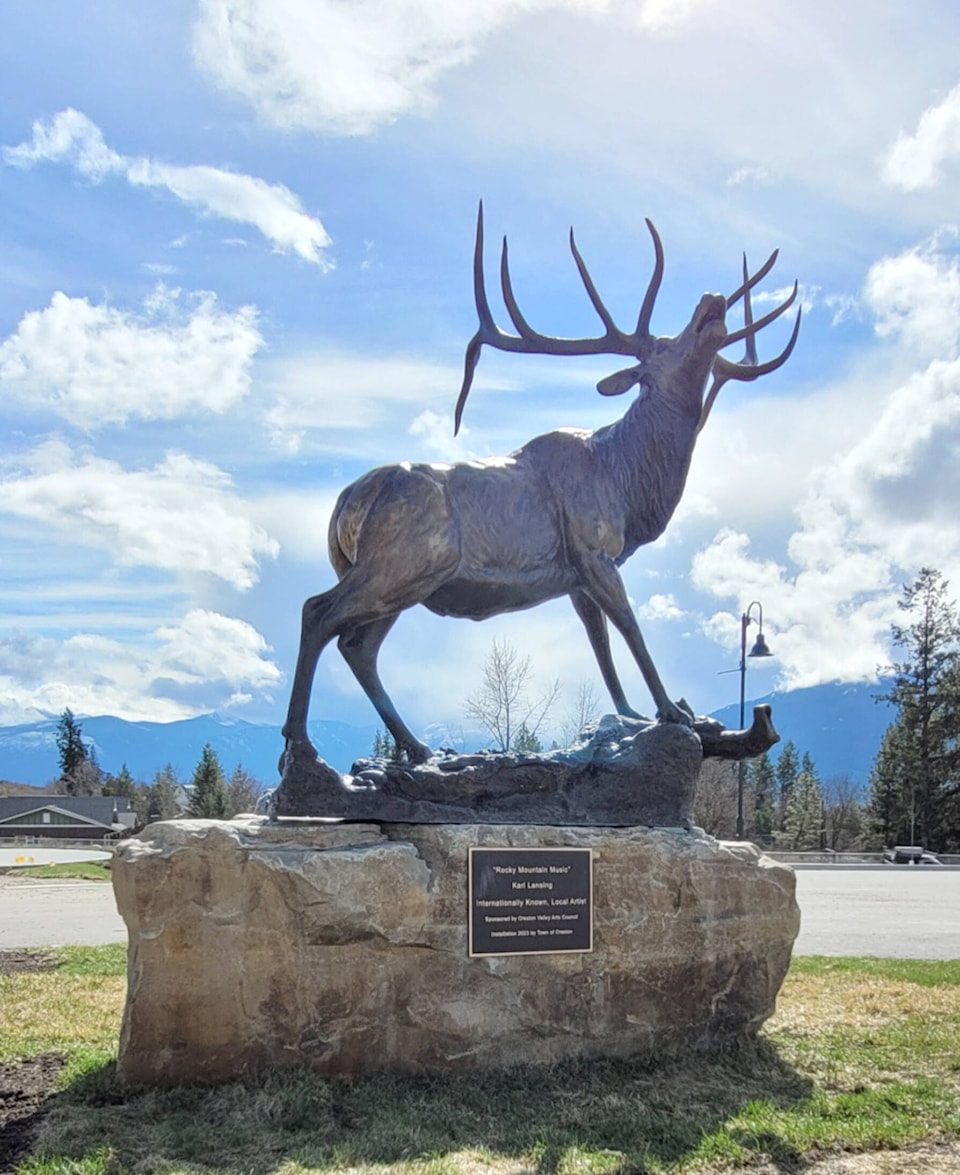Karl Lansing, Creston sculptor and taxidermist, is internationally renowned for his wildlife art, monumental pieces of the animals in bronze, with a life force so apparent, it feels like they could step right off their base and walk into the forest.
A new piece of Lansing’s is now gracing Creston — an elk sculpture set up in the new park off Cook Street, the new site of the Creston Farmers Market, and a Yaqan Nukiy interpretive centre. The bronze elk, bugling towards the sky, stands on a rock two feet high, and will greet visitors when the Farmers Market opens April 27.
“That particular sculpture is kind of a unique one, because it’s smaller than life-size,” Lansing said. “Usually, when I do monumental work, they’re larger than life-size — you go to one-and-a-quarter or one-and-a-third life-size, that’s kind of the standard.
“But I chose to do that one two thirds life-size to make it a little more acceptable as a piece that could be used in a garden setting, or a landscape setting, as well as a feature piece, where you would use more than likely put a monumental piece.”
At the same time, Lansing said, from a marketing point of view, a piece like that has a little bit more variety of where it can be placed.
“It turned out to be a pretty well accepted size — once I had it done and put it onto the market, I immediately got a number of offers on it. It showed to me that I was on the right track as far as overall size, as well as the presentation.”
This piece was purchased by the Community of Creston Arts Council, which works with the Town of Creston and Regional District of Central Kootenay Areas A, B and C in an effort to make the arts more visible in Creston Valley and to boost its profile as an arts and culture community. The piece was bought with a grant, in conjunction with the Yaqan Nukiy, and gifted to the Creston community to place in the Farmer’s Market park.
As a wildlife artist working in bronze, doing sculpture for more than 30 years, Lansing is renowned internationally, recognized for the realism and detail of his work.
“I strive to create realism. For me, the ultimate compliment is when someone is moved to say to me, ‘Does that ever look real.’ That’s when I feel I’ve accomplished what I’m striving to do.”
Sculpting in bronze is a labour intensive process, with the spirit of the piece travelling through a series of processes to reach its final form.
Lansing creates a “desktop-sized” model in clay, then a reproduction of that, is enlarged to size, in styrofoam, in the general shape of the piece he wants to create.
About an inch of clay is applied to that piece, and Lansing can work in all the detail and the texture and give it the look of a sculpted piece. Once that is done, then a mold is made of that piece.
“The larger the piece, the more you have to break the piece into sections, and cast those pieces separately,” he said. “The mold is made out of rubber, and once the mold is peeled off the surface of the sculpture, you lay wax up in your mold, and when the wax hardens, you peel the wax out of the mold, and what you have is a cast replica of the original sculpture.
The wax cast is taken to a foundry, which will build a ceramic shell around it, eventually firing that shell in a furnace, like ceramic. The molten metal is poured into the ceramic shell, and you are left with the metal casting, a representation of the original sculpture.
The pieces are then welded together.
“If you could look at the inside, it would look like a patchwork of metal plates all welded together. The weld seams are ground out and detailed, so on the outside it looks seamless, like it was cast as a single piece.”
The process is so labour intensive process, and requires so much equipment, that very few sculptors cast their own work. Lansing himself uses two different foundries, one in Kalispell, MT and another in Lehi, Utah.
When the foundry gets it to a finished state, Lansing will approve or disapprove the work. “If I see any flaws, we fix them at that time.”
The Creston elk sculpture has a metal thickness of one eighth to three eighths of an inch wide. It weighs about 400 pounds.
Lansing had been working on the elk over a period of eight to 10 years, only because he’d work on it for a while, then put it aside. “Partly because I was doing a piece that I wasn’t sure was going to be the right size for the market — I was apprehensive about it.
“But normally, it would take a couple of months, start to finish, without delays.”
The largest sculpture Lansing has done is a mountain lion, two and a half times life-size. It was commissioned by an individual in California, intended for a the front of a new office building. That piece took Lansing a year to complete.
For more about the artist Karl Lansing, see KarlLansing.com (Karl Lansing Fine Art).
